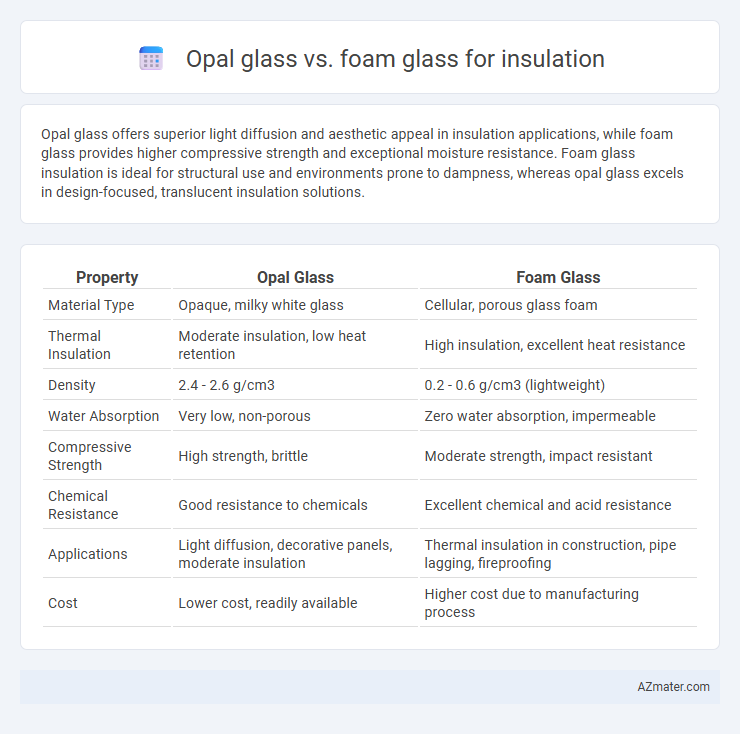Opal glass offers superior light diffusion and aesthetic appeal in insulation applications, while foam glass provides higher compressive strength and exceptional moisture resistance. Foam glass insulation is ideal for structural use and environments prone to dampness, whereas opal glass excels in design-focused, translucent insulation solutions.
Table of Comparison
| Property | Opal Glass | Foam Glass |
|---|---|---|
| Material Type | Opaque, milky white glass | Cellular, porous glass foam |
| Thermal Insulation | Moderate insulation, low heat retention | High insulation, excellent heat resistance |
| Density | 2.4 - 2.6 g/cm3 | 0.2 - 0.6 g/cm3 (lightweight) |
| Water Absorption | Very low, non-porous | Zero water absorption, impermeable |
| Compressive Strength | High strength, brittle | Moderate strength, impact resistant |
| Chemical Resistance | Good resistance to chemicals | Excellent chemical and acid resistance |
| Applications | Light diffusion, decorative panels, moderate insulation | Thermal insulation in construction, pipe lagging, fireproofing |
| Cost | Lower cost, readily available | Higher cost due to manufacturing process |
Introduction: Opal Glass vs Foam Glass for Insulation
Opal glass and foam glass are two distinct insulating materials with unique properties tailored for different applications. Opal glass offers excellent light diffusion and moderate thermal insulation, making it ideal for aesthetic and functional uses in interiors. Foam glass provides superior thermal insulation, high compressive strength, and moisture resistance, making it suitable for industrial and structural insulation needs.
Material Composition and Manufacturing Process
Opal glass insulation is primarily composed of soda-lime glass with added opacifying agents, which scatter light and enhance thermal performance, manufactured through a controlled melting and cooling process that ensures uniform opacity. Foam glass insulation consists of recycled glass cullet mixed with foaming agents like carbon or graphite, undergoing a high-temperature foaming process that creates a lightweight, closed-cell structure with excellent moisture resistance. The difference in material composition and manufacturing results in opal glass offering superior light diffusion and aesthetic properties, while foam glass provides higher compressive strength and better insulating value for industrial applications.
Thermal Insulation Properties Comparison
Opal glass and foam glass offer distinct thermal insulation properties, with foam glass exhibiting superior thermal resistance due to its closed-cell structure that minimizes heat transfer effectively. Opal glass, characterized by its translucent nature, provides moderate insulation but is best suited for applications requiring light diffusion rather than maximum thermal efficiency. Foam glass insulation typically achieves thermal conductivity values as low as 0.04 W/m*K, outperforming opal glass which generally ranges higher in thermal conductivity, making foam glass preferable for energy-saving insulation solutions.
Mechanical Strength and Durability
Opal glass offers moderate mechanical strength and good durability, making it suitable for applications where lightweight insulation with some structural integrity is required. Foam glass provides superior mechanical strength and excellent durability due to its closed-cell structure, which resists moisture, compression, and chemical damage more effectively than opal glass. The enhanced robustness of foam glass makes it ideal for demanding insulation environments exposed to heavy loads and harsh conditions.
Moisture and Chemical Resistance
Opal glass offers moderate moisture resistance but can absorb some water over time, potentially reducing its insulating properties. Foam glass excels in moisture resistance due to its closed-cell structure, preventing water infiltration and maintaining thermal performance. Chemically, foam glass is highly resistant to acids, alkalis, and solvents, whereas opal glass may be more susceptible to chemical degradation under harsh conditions.
Fire Resistance and Safety Features
Opal glass offers excellent fire resistance with non-combustible properties and high thermal stability, making it ideal for preventing fire spread in insulation applications. Foam glass insulation provides superior fire safety due to its inorganic composition and zero flame spread rating, ensuring effective thermal insulation while resisting ignition and toxic smoke emission. Both materials enhance building safety, but foam glass is often preferred for its lightweight nature and higher resistance to fire-related hazards in critical insulation environments.
Application Areas in Construction and Industry
Opal glass insulation is primarily used in architectural applications where light diffusion and aesthetic appeal are important, such as skylights, facades, and decorative panels, providing thermal regulation and glare reduction. Foam glass, with its high compressive strength and moisture resistance, is widely applied in industrial settings for pipeline insulation, refrigeration systems, and building foundations, offering superior thermal insulation and fire resistance. Both materials contribute to energy efficiency but are selected based on their structural and environmental performance tailored to specific construction and industrial requirements.
Environmental Impact and Sustainability
Opal glass insulation, made from recycled glass, offers excellent durability and energy efficiency with a lower carbon footprint compared to foam glass, which requires more energy-intensive production methods. Foam glass insulation contains cellular structures that trap air, enhancing thermal resistance while being fully recyclable and resistant to moisture and pests, contributing to long-term sustainability. Both materials support eco-friendly building practices, but opal glass's higher recycling content and lower embodied energy make it a more sustainable choice for reducing environmental impact.
Cost Analysis and Economic Benefits
Opal glass insulation generally offers lower initial costs compared to foam glass, making it a budget-friendly option for large-scale projects. Foam glass, despite higher upfront expenses, delivers longer-term economic benefits through superior durability, moisture resistance, and thermal efficiency, reducing maintenance and energy costs over time. The overall cost analysis favors foam glass for applications demanding longevity and performance, while opal glass suits projects with tighter budget constraints.
Conclusion: Choosing the Right Glass Insulation
Opal glass offers superior translucency and aesthetic appeal, making it ideal for applications where light diffusion and design are priorities, while foam glass excels in thermal insulation, moisture resistance, and structural strength, suited for industrial and high-performance insulating needs. Foam glass's closed-cell structure provides outstanding durability and fire resistance, outperforming opal glass in harsh environmental conditions. Selecting the right glass insulation depends on balancing thermal efficiency, mechanical properties, and visual requirements specific to the project's environment and purpose.

Infographic: Opal glass vs Foam glass for Insulation
 azmater.com
azmater.com